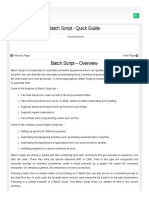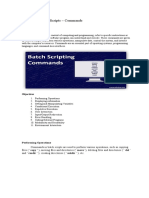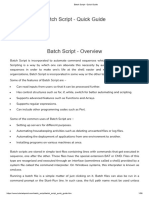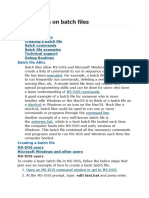0% found this document useful (0 votes)
181 views3 pagesBatch Scripting Basics Guide
This guide provides an overview of common commands used in Windows batch scripting, including ECHO, SET, IF, and SHUTDOWN, along with their usage and examples. It also covers additional commands like PAUSE, TIMEOUT, and FINDSTR, and explains how to manage output redirection. Users are advised to save scripts with .bat or .cmd extensions and run them as administrator when necessary.
Uploaded by
ytmvlogsCopyright
© © All Rights Reserved
We take content rights seriously. If you suspect this is your content, claim it here.
Available Formats
Download as PDF, TXT or read online on Scribd
0% found this document useful (0 votes)
181 views3 pagesBatch Scripting Basics Guide
This guide provides an overview of common commands used in Windows batch scripting, including ECHO, SET, IF, and SHUTDOWN, along with their usage and examples. It also covers additional commands like PAUSE, TIMEOUT, and FINDSTR, and explains how to manage output redirection. Users are advised to save scripts with .bat or .cmd extensions and run them as administrator when necessary.
Uploaded by
ytmvlogsCopyright
© © All Rights Reserved
We take content rights seriously. If you suspect this is your content, claim it here.
Available Formats
Download as PDF, TXT or read online on Scribd
/ 3















































